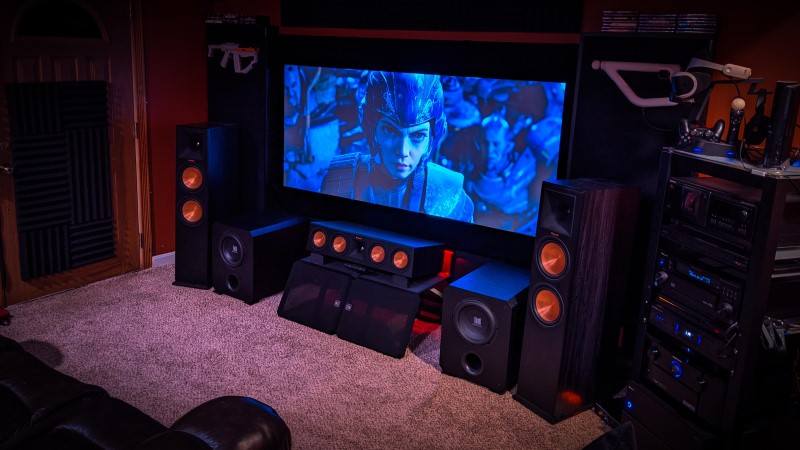Why A Big Subwoofer is (Sometimes) a Waste of Money
We love our subwoofers around here, but the “bigger is better” mentality isn’t always correct. Buying a big subwoofer and shoehorning it into a small room is just a waste of money. But you want BIG bass. You want all the bass. You want bass that will scare people. Bass that causes people to question their religion. The kind of bass that makes you wonder if you are feeling sick or if your brain fluid is being vibrated by the subs. We get it. We want that too. And you can have it. But the “big” subwoofer is not the path, it is a waste of money. The correctly-sized subwoofer is the path. Let’s discuss.
Why You Want the Big Subwoofer
You’ve been conditioned by marketers and just about everyone you know that if something is good, more of it is better. That can be quickly disproved by adding too much salt to anything. But to get the big bass, you need a big subwoofer, right? Not necessarily. What you want is enough bass for your room, and to hit a specific frequency in the extension. The reality is that if you do nothing but listen to music, you only need your subwoofer to hit around mid-30Hz to capture nearly all the music (unless you are really into organ music?). If you will be watching movies, your subwoofer should extend down to 20Hz. If possible, a little below. There is exceedingly little content below 20Hz, but there is some. If you want to capture all of it, you’ll want a subwoofer that can dip down a couple of Hz below 20. That takes a big box, right? Not necessarily.

When the Small Subwoofer is the Correct Subwoofer
Do you have a dedicated home theater space (a room that is enclosed)? Is that space reasonably sized (the size of a large bedroom or smaller)? Then you don’t need a massive subwoofer to realize extension into the upper teens. There are lots of companies out there that make reasonably priced (and sized) subwoofers that will give you the extension you want.
The real question isn’t whether the subwoofer will give you the extension you want, but if it will give you the output (volume). Usually, a subwoofer that can play low can also play reasonably loud. But can it play loud enough for your room?
The Case for the Big Subwoofer
Looking at subwoofer specifications can be confusing. They don’t exactly make sense just on the page even to those of us that are used to looking at them. It is especially hard if the manufacturers are the ones providing the measurements.
That said, subwoofer reviews love to talk about room size when reporting on subwoofers. They’ll let you know if a sub is appropriate for a specific size. You might have to do a search to see what they mean by a specific size rating (there is no standardization of room size among reviewers), but the information is there.
So, you’ve found a subwoofer, it is in your budget, it is rated for your room, and it has the extension you want. But…it has a bigger brother that is only a couple of hundred dollars more and has more output and maybe a little more extension. Surely, that is worth purchasing!
When the Big Subwoofer is a Waste of Money
And that’s where this discussion always goes off the rails. If a sub that does all the things you need, surely a sub that can do MORE than what you need is better? In objective terms, the bigger sub is more capable. But in your room, you’ll never experience it.
When you run your room correction program, it asks you to adjust the volume of your subwoofer so that it can set the trim level. If that volume is anywhere south of Max, that sub can get loud enough for your room. Loud enough means it can hit full reference volume. This means it can hit peaks of 115dB in your room. In layman’s terms, it can get freaking loud. Loud as a movie theater.
The difference between the correct sub for your room and the bigger sub is that you’ll set that volume knob lower on the bigger subwoofer. Users call this “headroom.” We call this a waste of money. This is the ability for the subwoofer to play louder than you need. But you’ll never experience it because you’ll never need it. You’ve just wasted money on a big sub just so you can set the volume lower? Does that seem like a smart investment?
Conclusion
For most reasonably-sized rooms, finding a subwoofer that gives you the extension you want, usually gets you a sub that can get louder than what you need. That is not buying a “big” subwoofer. It is really hard to perfectly match both the extension and output to your room size. Usually, one will be the limiting factor. If you have a massive room, to get the output you need, you’ll probably end up with a sub that can play lower than you might have chosen. That’s fine. That’s the correct subwoofer for your room.
It is when you buy a sub because it can exceed everything you need it to do, that you are wasting money on your subwoofer purchase. It’s hard to look at that larger subwoofer and not buy it when you know it is technically better. But you’ll never hear that difference. If you put the correct subwoofer for your room next to one that can play 10x’s louder, you’ll think they sound exactly the same. Save that money and spend it on something else. Like room treatments or a second subwoofer. That’ll make way more difference in the bass you experience than a larger subwoofer.


